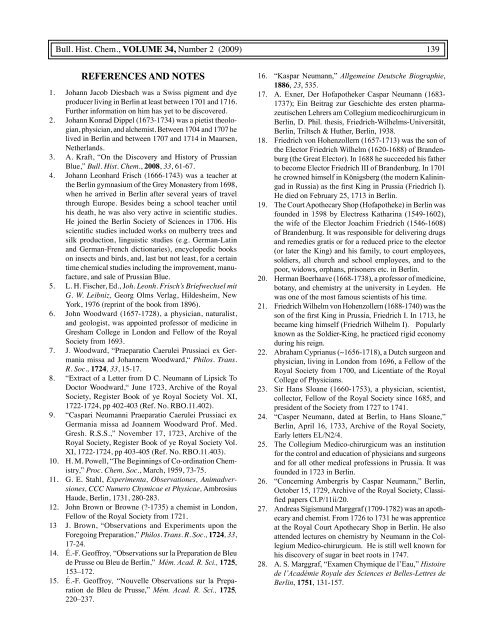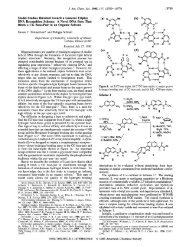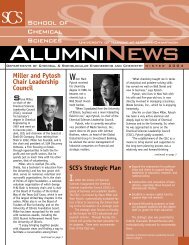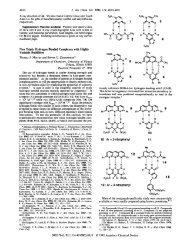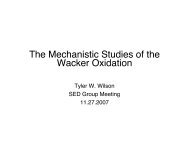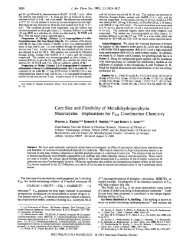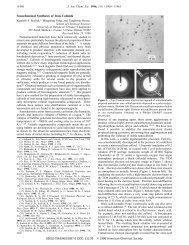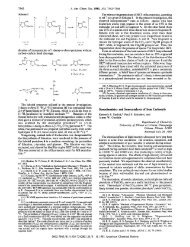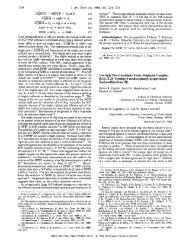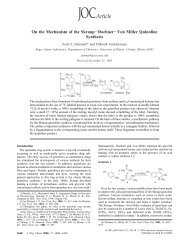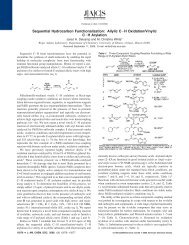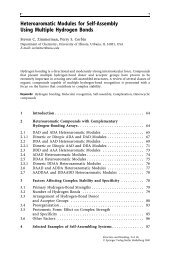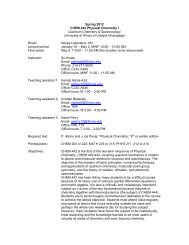On tWO LEttErs frOM casPar nEUMann tO JOhn WOOdWard ...
On tWO LEttErs frOM casPar nEUMann tO JOhn WOOdWard ...
On tWO LEttErs frOM casPar nEUMann tO JOhn WOOdWard ...
Create successful ePaper yourself
Turn your PDF publications into a flip-book with our unique Google optimized e-Paper software.
Bull. Hist. Chem., VOLUME 34, Number 2 (2009) 139<br />
rEfErEncEs and nOtEs<br />
1. Johann Jacob Diesbach was a Swiss pigment and dye<br />
producer living in Berlin at least between 1701 and 1716.<br />
Further information on him has yet to be discovered.<br />
2. Johann Konrad Dippel (1673-1734) was a pietist theologian,<br />
physician, and alchemist. Between 1704 and 1707 he<br />
lived in Berlin and between 1707 and 1714 in Maarsen,<br />
Netherlands.<br />
3. A. Kraft, “<strong>On</strong> the Discovery and History of Prussian<br />
Blue,” Bull. Hist. Chem., 2008, 33, 61-67.<br />
4. Johann Leonhard Frisch (1666-1743) was a teacher at<br />
the Berlin gymnasium of the Grey Monastery from 1698,<br />
when he arrived in Berlin after several years of travel<br />
through Europe. Besides being a school teacher until<br />
his death, he was also very active in scientific studies.<br />
He joined the Berlin Society of Sciences in 1706. His<br />
scientific studies included works on mulberry trees and<br />
silk production, linguistic studies (e.g. German-Latin<br />
and German-French dictionaries), encyclopedic books<br />
on insects and birds, and, last but not least, for a certain<br />
time chemical studies including the improvement, manufacture,<br />
and sale of Prussian Blue.<br />
5. L. H. Fischer, Ed., Joh. Leonh. Frisch’s Briefwechsel mit<br />
G. W. Leibniz, Georg Olms Verlag, Hildesheim, New<br />
York, 1976 (reprint of the book from 1896).<br />
6. John Woodward (1657-1728), a physician, naturalist,<br />
and geologist, was appointed professor of medicine in<br />
Gresham College in London and Fellow of the Royal<br />
Society from 1693.<br />
7. J. Woodward, “Praeparatio Caerulei Prussiaci ex Germania<br />
missa ad Johannem Woodward,“ Philos. Trans.<br />
R. Soc., 1724, 33, 15-17.<br />
8. “Extract of a Letter from D C. Neumann of Lipsick To<br />
Doctor Woodward,“ June 1723, Archive of the Royal<br />
Society, Register Book of ye Royal Society Vol. XI,<br />
1722-1724, pp 402-403 (Ref. No. RBO.11.402).<br />
9. “Caspari Neumanni Praeparatio Caerulei Prussiaci ex<br />
Germania missa ad Joannem Woodward Prof. Med.<br />
Gresh. R.S.S.,” November 17, 1723, Archive of the<br />
Royal Society, Register Book of ye Royal Society Vol.<br />
XI, 1722-1724, pp 403-405 (Ref. No. RBO.11.403).<br />
10. H. M. Powell, “The Beginnings of Co-ordination Chemistry,”<br />
Proc. Chem. Soc., March, 1959, 73-75.<br />
11. G. E. Stahl, Experimenta, Observationes, Animadversiones,<br />
CCC Numero Chymicae et Physicae, Ambrosius<br />
Haude, Berlin, 1731, 280-283.<br />
12. John Brown or Browne (?-1735) a chemist in London,<br />
Fellow of the Royal Society from 1721.<br />
13 J. Brown, “Observations and Experiments upon the<br />
Foregoing Preparation,” Philos. Trans. R. Soc., 1724, 33,<br />
17-24.<br />
14. É.-F. Geoffroy, “Observations sur la Preparation de Bleu<br />
de Prusse ou Bleu de Berlin,” Mém. Acad. R. Sci., 1725,<br />
153–172.<br />
15. É.-F. Geoffroy, “Nouvelle Observations sur la Preparation<br />
de Bleu de Prusse,” Mém. Acad. R. Sci., 1725,<br />
220–237.<br />
16. “Kaspar Neumann,” Allgemeine Deutsche Biographie,<br />
1886, 23, 535.<br />
17. A. Exner, Der Hofapotheker Caspar Neumann (1683-<br />
1737); Ein Beitrag zur Geschichte des ersten pharmazeutischen<br />
Lehrers am Collegium medicochirurgicum in<br />
Berlin, D. Phil. thesis, Friedrich-Wilhelms-Universität,<br />
Berlin, Triltsch & Huther, Berlin, 1938.<br />
18. Friedrich von Hohenzollern (1657-1713) was the son of<br />
the Elector Friedrich Wilhelm (1620-1688) of Brandenburg<br />
(the Great Elector). In 1688 he succeeded his father<br />
to become Elector Friedrich III of Brandenburg. In 1701<br />
he crowned himself in Königsberg (the modern Kaliningad<br />
in Russia) as the first King in Prussia (Friedrich I).<br />
He died on February 25, 1713 in Berlin.<br />
19. The Court Apothecary Shop (Hofapotheke) in Berlin was<br />
founded in 1598 by Electress Katharina (1549-1602),<br />
the wife of the Elector Joachim Friedrich (1546-1608)<br />
of Brandenburg. It was responsible for delivering drugs<br />
and remedies gratis or for a reduced price to the elector<br />
(or later the King) and his family, to court employees,<br />
soldiers, all church and school employees, and to the<br />
poor, widows, orphans, prisoners etc. in Berlin.<br />
20. Herman Boerhaave (1668-1738), a professor of medicine,<br />
botany, and chemistry at the university in Leyden. He<br />
was one of the most famous scientists of his time.<br />
21. Friedrich Wilhelm von Hohenzollern (1688-1740) was the<br />
son of the first King in Prussia, Friedrich I. In 1713, he<br />
became king himself (Friedrich Wilhelm I). Popularly<br />
known as the Soldier-King, he practiced rigid economy<br />
during his reign.<br />
22. Abraham Cyprianus (∼1656-1718), a Dutch surgeon and<br />
physician, living in London from 1696, a Fellow of the<br />
Royal Society from 1700, and Licentiate of the Royal<br />
College of Physicians.<br />
23. Sir Hans Sloane (1660-1753), a physician, scientist,<br />
collector, Fellow of the Royal Society since 1685, and<br />
president of the Society from 1727 to 1741.<br />
24. “Casper Neumann, dated at Berlin, to Hans Sloane,”<br />
Berlin, April 16, 1733, Archive of the Royal Society,<br />
Early letters EL/N2/4.<br />
25. The Collegium Medico-chirurgicum was an institution<br />
for the control and education of physicians and surgeons<br />
and for all other medical professions in Prussia. It was<br />
founded in 1723 in Berlin.<br />
26. “Concerning Ambergris by Caspar Neumann,” Berlin,<br />
October 15, 1729, Archive of the Royal Society, Classified<br />
papers Cl.P/11ii/20.<br />
27. Andreas Sigismund Marggraf (1709-1782) was an apothecary<br />
and chemist. From 1726 to 1731 he was apprentice<br />
at the Royal Court Apothecary Shop in Berlin. He also<br />
attended lectures on chemistry by Neumann in the Collegium<br />
Medico-chirurgicum. He is still well known for<br />
his discovery of sugar in beet roots in 1747.<br />
28. A. S. Marggraf, “Examen Chymique de l’Eau,” Histoire<br />
de l’Académie Royale des Sciences et Belles-Lettres de<br />
Berlin, 1751, 131-157.


